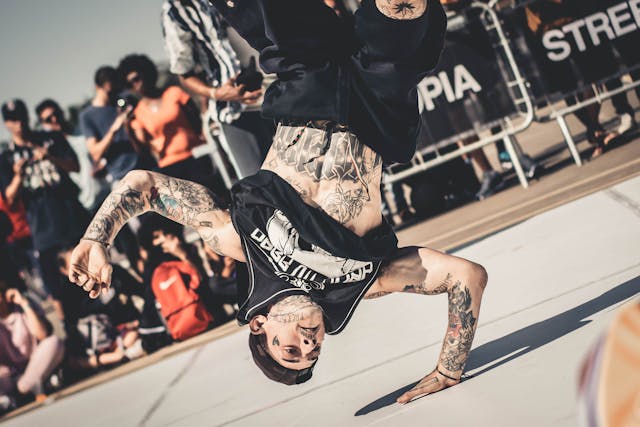
Why is breakdancing called breakdancing? Breakdancing was dancing that filled a break in the music.
Breakdancing is generally only called breakdancing by the general public. People who breakdance are called breakers, or break-boy (b-boy) and break-girl (b-girl). Breakdancing is a type of dance, but b-boys and b-girls live a lifestyle which has a culture of its own. I’m going to use the term breakdancing because it is the most commonly known.
Breakdancing came about in the 1970s in New York and it grew out of the rising hip hop culture. Just like the punk movement came out of economic depression, hip hop arose the same way. In the late 1960s and all through the 1970s, New York underwent an economic depression. After the end of World War 2, the American economy rose because of all the rebuilding that was needed. However, once other countries got back on their feet, there was no longer much call for a lot of industries in America and they started to shut down. At the same time, there was a lot of immigration into New York during America’s second great immigration wave, the first one being from 1880 to 1920. Immigrants settled in certain areas of the city and middle-class people started to move out of the city to the suburbs. More industries shut down or moved out of the city and immigration sky rocketed. At the same time, the Cross Bronx Expressway was built right through the center of the city. At a time when the city didn’t have any money, this was a hugely expensive project and it decimated the city blocks it was built through. Often, the poor immigrant or African American communities that lived there were relocated to very poorly built housing projects. New York didn’t recover until the end of the 1970s and there was over a decade of high unemployment, strikes, and black outs. Crime rates rose across the city and things were looking pretty bleak. That is the environment that hip hop came out of.
Because the city was falling apart, there were a lot of abandoned buildings. People started using them for block parties. At the time, Jamaicans living in New York used sound systems with very powerful speakers and mixing boards that could sample different music. The MCs also performed something called “toasting”, which would become rapping. The African American communities, particularly in the Bronx, started using these sound systems and several of the musical forms that the Jamaicans had been using, and made it their own. Hip hop had an MC, a DJ, walls for graffiti, and a place to dance. Three of the most important influences in the early days of hip hop were DJ Kool Herc, Afrika Bambaataa, and Grandmaster Flash. They all brought their own styles to the table and are known as the Holy Trinity of hip hop.
DJ Kool Herc, one of these three DJs, is credited with the creation of breakdancing. DJ Kool Herc played lots of soul and funk music that had break sections where there was only percussion and no vocals. He noticed that during these breaks that only had a beat, people would come onto the dance floor and dance in a very fast and energetic way. They knew the break wasn’t very long and wanted to get in their best moves. DJ Kool wanted to give them more time to dance in this break, so he started playing two copies of the same record on different turntables so he could jump between them and add in more and longer breaks. He called the people that were dancing in these breaks, break-boys and break-girls.
People wanted to perform better moves than other people and breakdancing battles took off. Spectators would form a circle known as a cypher and the two dancers would perform inside it. There is one theory that this style of competitive dancing in a circle might have been brought to America by Africans that were taken as slaves. From these early block parties, hip hop and break dancing began to expand and become more well known. Breakdancing crews started to form and in the early 1980s, they were picked up by the mainstream media in America. The first use of the term breakdancer was given by mistake in a newspaper interview in 1980 by the manager of Rock Steady Crew and that is the name that was attached to it, which annoys most true breakers. Since the 1980s, a lot of other dance forms have become connected to breakdancing as well, such as popping and locking, but these are very different forms of dance. And this is what I learned today.
Photo by Wallace Chuck: https://www.pexels.com/photo/crowd-watching-a-man-doing-breakdancing-2820897/
Sources
https://en.wikipedia.org/wiki/Hip_hop_(culture)
https://en.wikipedia.org/wiki/Hip_hop_music
https://en.wikipedia.org/wiki/DJ_Kool_Herc
https://www.iconcollective.edu/hip-hop-history
https://en.wikipedia.org/wiki/Cross_Bronx_Expressway
https://www.mygrooveguide.com/dance-info/breaking/history-of-breaking
https://www.redbull.com/int-en/history-of-breaking
https://en.wikipedia.org/wiki/History_of_New_York_City_(1946%E2%80%931977)
https://en.wikipedia.org/wiki/Breakdancing
https://www.hofstra.edu/pdf/academics/colleges/hclas/cld/cld_rlr_f01_ellisisland.pdf
